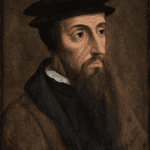John’s description of the land beast and his work in Revelation 13:11-15 is organized in a fairly neat chiasm:
A. Another beast like a lamb, speaking as a dragon, 13:11
B. He has the authority of the first beast, 13:12a
C. He makes land-dwellers worship the first beast, who was healed of a deadly plague, 13:12b
D. He performs great signs before men, 13:13
D’. He deceives land-dwellers with signs done before the beast, 13:14a
C’. He tells land-dwellers to make an icon of the beast who had the plague of the sword and came to life, 13:14b
B’. He was given to give spirit to the icon of the beast, 13:15a
A’. So that the icon might speak, so that those who refuse to worship the icon will be killed, 13:15b
Analyzing the structure we find these parallels:
A/A’: The verbal links are fairly weak, but they are there. Both refer to speech, using the verb laleo. The word “beast” appears in A and twice in A’. If we can make this connection, it suggests that “speaking as a dragon” is connected to the speaking of the icon and killing those who refuse to worship the icon.
B/B’: Again the verbal links are comparatively weak. Both refer to the sea beast. There is perhaps a conceptual connection in the notion that the land beast has the authority of the first beast (B) and the authority or power that the land beast has to give spirit/breath to the icon of the beast.
C/C’: As we move to the center, the verbal links between the sections get very strong. C and C’ both use the word “land” (ge); both refer to “dwellers” on the land; both mention the sea beast; both refer to the wound (plege) of the beast that was healed. In C, the land beast makes the land-dwellers worship the sea beast; in C’, he makes the land-dwellers build an icon of the beast, which is eventually worshiped (A’). The beast-worship of C becomes focused in C’ in the construction and worship of the icon of the beast.
D/D’: Again, the verb echoes are quite strong: Both sections refer to “signs”; both mention “land”; both end with a reference to the performance of signs “before” (enopion) someone – before men, then before the beast. (Does this indicate a progression? Does the land beast first dazzle men, then is rewarded with an audience before the sea beast?) C mentions the specific Elijah signs of fire from heaven; C’ indicates that the signs are for the purposes of deception (whether the signs themselves are deceptive or the signs are real but cause deception is unclear).
There are a couple of other neat literary-theological twists in the section. As the chiasm indicates, the turning points comes with the performance of signs. Prior to the D section, the land beast is “making” the land-dwellers worship the first beast, but it is not clear how he does that. The signs provide an explanation of his persuasiveness and his deceptiveness. The icon (or image) of the beast isn’t mentioned until C’, after the signs have been mentioned, but then the word eikon dominates the remainder of the section, used four times, in nearly every line of C’-A’. Every time the word “beast” is used in C’-A’, it is linked to eikon. (In verse 14, the icon is “to the beast”; in verse 15, the phrase “icon of the beast” is used three times, an insistent refrain.)
The sequence suggests a Mosaic typology running behind the more overt Elijah typology. As Moses performed signs that persuaded the people to turn to Yahweh, and then constructed a tabernacle as an image of the glory of Yahweh, so the land beast performs signs and then puts the land-dwellers to work making an icon of the beast to worship. The Mosaic typology is fairly strict, since Israel’s first construction at Sinai was not the tabernacle but an image of a beast, the golden calf (Exodus 32).
And behind the Mosaic is an Adamic sequence: Adam was formed from the dust, enlivened by the breath of God, made to speak and worship. The image of the beast is the image of deified man: Once the icon is made, he is given breath, made to speak, and worshiped. He is an Adam who wishes, like the first Adam, to be as God.
Finally, the final word of the whole section is apoktanthosin, “to be killed” (v. 15). It’s a neatly definitive way to end a section, with a reference to a definitive end of life. The beast who suffered a wound and rose again assumes authority to kill; the beast who was slain by the sword now kills with the sword.














